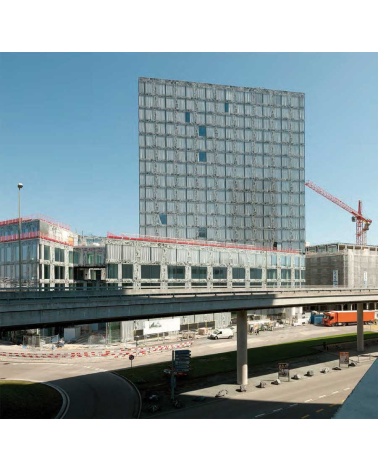Allianz Headquarters
Wiel Arets, Felix Thies, Maik Ilmer
Location: Zurich, Suiza
Date: 2013
Photography: Jan Bitter
| Format | |
| Pages | 20 |
| Language | Spanish, English |
The new Allianz Suisse Headquarters is located in two buildings that correspond to contours defined by an urban plan set by Vittorio Lampugnani. Allreal, the owner of the buildings in the Richti Quartier, organized a series of workshops with the different architects to coordinate the different building blocks, concerning building height, entrances, façade and ground floor spaces.
The Allianz complex is composed of a high rise and a 5-storey building and contains a diverse office program. It defines the edges of the block according to the urban plan. Both buildings in the complex are connected to one another through a series of bridges that enable the various office, gastronomic and retail facilities to accommodate one another and interact fluently.
Taking the concept of “interiority” literally, the building produces a spatial, programmatic and atmospheric variety within. The pure layering of floors is broken through a series of voids that link individual floors visually and physically. These voids create shortcuts between floors using open stairways, which produces new and unexpected visual and spatial relations.
Because these voids were planned as an option in the structure, in many regards the building becomes more adaptable to individual use, and creates the possibility of a more vertical rental arrangement for respective tenants. The integration of a variety of gastronomic, educational and leisure related functions align with the intention of creating a stimulating work environment.
These additional programmatic functions weave through the building, beginning with an auditorium and an espresso bar in the lobby of the high-rise, through a “working restaurant”, a café and project rooms with roof gardens on the 5th floor.
A daycare centre for children and a business center further contribute to this additional program. Through this distribution of integrated programs, a manifold work world with references to the city realm emerges. At the same time, the diversity enables different atmospheres within a homogeneous frame. The lobby can—similar to a hotel reception—relate to different activities. It could, for instance, become a foyer for a lecture hosted by the local university taking part in the auditorium.
A multitude of conditions were developed that allow team areas, calm zone cabins, flexible jobs and lounge areas to be situated next to individual work stations, for informal working. Structural glazing, partially printed using silkscreen techniques, composes the envelope of both buildings. A silver curtain acts as sun protection within the façade void by means of a central control; the building envelope can thus react to changing light conditions.
Structural elements were, when possible, integrated into other building components to secure a high grade of flexibility in support-free areas. Large spans are used to minimize the amount of structural elements. The choice of material and lighting is based on longevity and comfort, which allows the development of different zones and atmospheres within the interior.
No customer reviews for the moment.





